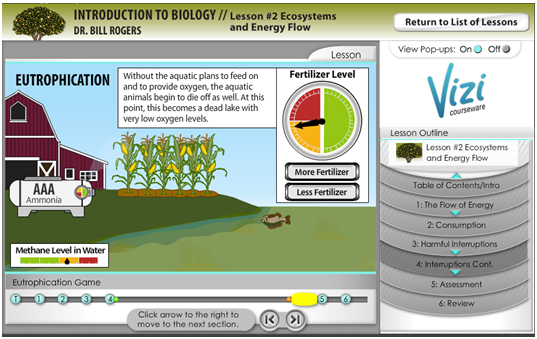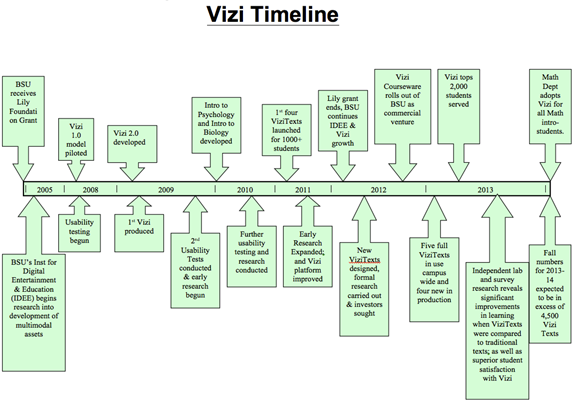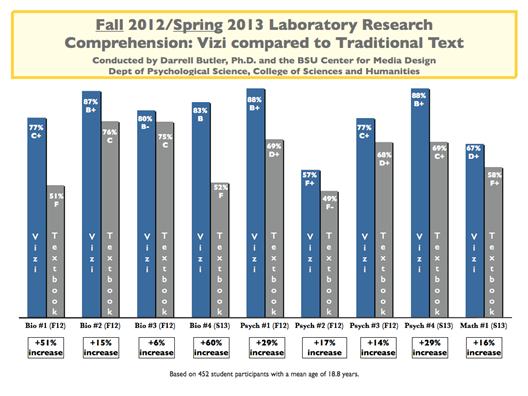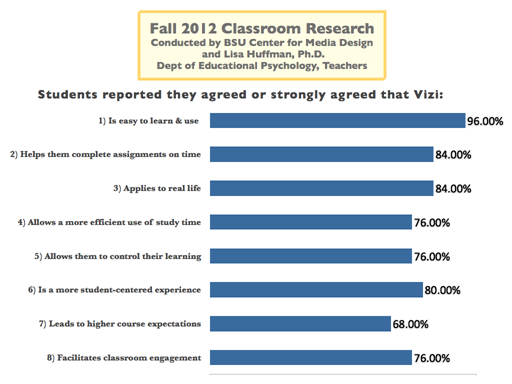Key Takeaways
- In a lab research study at Ball State University, Vizi Courseware's multimodal texts significantly improved student performance over traditional texts.
- In classroom survey research, the majority of students reported higher levels of personal engagement, a sense of how the learning related to their worlds, and satisfaction with courses taught using Vizi resources.
- The flexibility of multimodal texts frees professors to teach the way they want (traditional, blended or flipped style) while improving the learning outcomes of their students.
Like virtually all institutions of higher education, Ball State University (BSU) faces the issues of decreasing four-year graduation rates; core classes with rising numbers of students earning D and F grades or withdrawing; and concerns about a perceived decrease in academic rigor. Indeed, those concerns are not unique to Ball State or its instructors; they are endemic to all institutions of higher learning.
In 2005 BSU's Institute for Digital Education and Entertainment (IDEE) accepted the challenge of searching for answers to a host of questions related to those issues:
- Can new media develop tools that engage students in their studies and an academic learning process?
- Can these tools bring students and teachers closer together in academic learning environments regardless of class size?
- Is there a technology solution that exploits the desire of today's students to use web-based technology, that stimulates learning by using multimodal learning strategies, that is created with attention to increased academic rigor, and that simultaneously improves student outcomes and four-year graduation rates?
These questions became the mandates for a solution.
Vizi
Example of Vizi Courseware learning (1:45 minutes)
Ball State had secured funding to help IDEE develop a solution we called Vizi, a technology-centered resource that meets students where they live: online. Vizi uses a rigorously designed pedagogy that triggers multiple learning centers in the brain through multimodal learning experiences such as video, simulations, games, and interactive exercises. As a result, Vizi helps students achieve specific learning objectives and test their actual mastery of a subject. A video example from Introduction to Psychology demonstrates how Vizi approaches learning for a student studying Erickson's Eight Stages of Development. In it you can see how the Vizi platform is laid out and operates, as well as one example of Vizi's ability to encourage student learning.
More than 4,000 Ball State students have so far used Vizi's Introduction to Biology (figure 1), Introduction to Psychology, Math in the Liberal Arts, Design Interactive II, Students with Advanced Potential (a certification course for teachers), and Rhetoric, Composition, and Expression for a Digital Age (English rhetoric in today's society). In fall 2013, three new ViziTexts will be launched: Juvenile Justice and Delinquency, Basic Electricity in Information and Communication Technology (a Vizi that provides learners in many disciplines a basic knowledge of electricity), and Avoiding Sexual Violence (part of a workshop aimed at protecting and empowering women and minorities).

Distinguished Professor Jennifer Palilonis describes Vizi's ability to engage students and their responses to that interaction (1:04 minutes).
While designed to be engaging for students, Vizi also was designed to be versatile for instructors, regardless of their teaching style. For instance, traditional instructors who lecture and assign resources outside of class can capitalize on the common vocabulary and learning experiences of their students by "assigning" Vizi either in place of or along with a traditional text. Instructors who favor a more blended style for the classroom may use Vizi's media to illustrate a point, as a classroom exercise, or as a jumping-off point for in-class work. Instructors who prefer a "flipped" classroom can use the Vizi as an outside resource that prepares students for a "working" classroom facilitated by the instructor as subject matter expert. Built-in analytics, meanwhile, provide daily reports to the instructor that track individual study habits (the number of times a student opens the ViziText and the number of interactions in which they engage).
In this video, a math teacher with 30 years of experience speaks of Vizi's flexibility and points out its value for teachers and students (1:06 minutes).
Also, while each Vizi is designed to fit the outcome objectives established for each lesson, the design is flexible as well as textbook agnostic. That means, should an instructor want to use a traditional textbook along with a Vizi, virtually any standard beginning text will work.
Finally, Vizi is delivered in the cloud, which makes two things possible:
- First, it's easy to scale the size of a class from 50 to 500 to 5,000;
- Second, it's possible to add material to a Vizi as desired by instructors to fit the demands of their class or institution.
Creating a Multimodal Experience
One major value underlying Vizi is the understanding that information should be active, not passive, to truly engage students. To that end, Vizi uses multimodal technologies to ignite the brain's many learning centers and engage students with course content. Unlike traditional textbooks, which drive learning through a single channel, Vizi drives learning through a combination of media to create a multimodal experience. The goal of those experiences is more than just engagement, however — it is to help students meet specific pedagogical goals and objectives as they advance through a course.
Engagement leads to multiple solutions as described by Professor David Perkins (1:14 minutes).
For instance, in Vizi's Math in the Liberal Arts, the lesson on probabilities establishes a clear objective:
"Students will be able to calculate probabilities and use those results to make educated decisions based on identifying the inter-relationships among probabilities, odds, and expected values."
The lesson then provides students with the knowledge and skills to meet that objective by setting a number of tasks and sub-objectives that lead to an assessment of their progress. Students unlock that knowledge through their interactions with original media created specifically to support those objectives. Those interactions not only help students learn, they also provide students with practice before the final assessment. In that assessment, learners demonstrate their ability to accomplish the objective; they must use an interactive format that begins with a story problem and the odds against the event posed in the problem. The students then calculate the probability of the event happening and make decisions based on the expected value. Objective accomplished.
Research-Proven Standards and Design Principles
Almost from its inception, Vizi has undergone constant evaluation and research. At every phase of development, theories have been tested and changes have resulted. For instance, testing of the first Vizi focused on creating a software platform that would achieve linear and nonlinear entertaining engagements. The content was not original — it was borrowed from BSU's Electronic Field Trip series. Students worked on the content and found ways to make it more appealing to them by using music, animations, etc. The assumption was that the test subjects ("digital natives") would be interested almost exclusively in the media, in being entertained. However, during the testing process, evaluators noticed that instead of students constantly playing with media, they also read all of the text included. Their media experiences seemed to awaken their interest and motivate them to read in an effort to learn more.
While the usability results were superior, the idea that media would engage learning in this manner sent the team back to the drawing boards to develop a platform with a stronger focus on pedagogy. In turn, that resulted in the fashioning of a process for the creation of original media that would drive learning and lead students to their studies (text or otherwise). These were the early days in digital education, but the idea of multimodal learning was taking shape, and that would lead to more organized and pedagogically sophisticated versions of Vizi.
The first ideas for what became Vizi emerged from a 2005 meeting with the National Academies of Science in Washington, D.C. Academy officials wanted to see if a single media piece — televised video, for example — could speak to and inform average people, as well as city officials in charge of reducing carbon footprints. The answer at that time was "No." Linear media (text or video) tends to speak to a specific constituency and doesn't work well with audiences that have differing degrees of knowledge about a subject. However, what would eventually become Ball State's Vizi team began searching for an approach that would work.1 Figure 2 shows the development timeline for Vizi beginning with the original grant.

In 2006 the team began to explore whether it could create a resource that would speak to diverse groups of learners — specifically classrooms, where a small number of students typically have in-depth knowledge of a subject but most have little or no familiarity. The first Vizi multimodal texts were intended to test the idea of a web-based multimedia "text" and were designed more to engage than to inform. When usability tests suggested students were engaged with the Vizi approach and preferred media (and the web) to traditional textbooks as a primary learning tool, the team began work (in 2007) on a more academic version of Vizi.
Tests of the user experience in 2008 again confirmed that Vizi was on the right track, so assessments that measured learning were developed. Early results of those tests suggested that a more rigorous design process would be required to support student learning. By 2009, designers were looking to apply scientific methodologies to Vizi.
This video demonstrates Mayer and Moreno's work as applied to and active in Vizi (1:54 minutes).
The work of educational psychologists Richard Mayer and Roxanna Moreno was adopted as the standard for development. Mayer ranked as the most productive educational psychologist in the world for 1991–2001. He and Moreno have made significant contributions to theories of cognition and learning, especially as they relate to the design of educational multimedia.2
In addition, Vizi designers have used the research of many others in the fields of communication and the arts to develop the content design process of each Vizi. The end result is a multimodal text that is compelling, adheres to a rigorous pedagogical approach, and uses knowledge of the science of multimodal learning as its standard for design and development. That leads to two obvious questions: Has this more rigorous version of Vizi been tested to see if it supports learning? and Did it pass? The answer to both is "yes."
Results of BSU's Lab and Classroom Research
Ball State completed two major studies in the 2012–13 academic year to evaluate Vizi's effectiveness and acceptance by students. BSU's Office of the Provost made two grants to fund the studies. One went to Darrell Butler, a cognitive scientist and professor of psychology, who used his department's psych lab to study Vizi compared to traditional texts. The second grant went to Lisa Huffman in Ball State's Teachers College, who surveyed student reactions to Vizi as a study and course resource.
Butler and his team tested more than 450 students in a laboratory environment. The students were divided into two groups, each of which was given 45 minutes to study either a multimodal or traditional text. All texts contained the same information; the traditional text was extracted from major educational textbooks in the field. Students then took identical examinations. In all cases, students who used Vizi's multimodal texts outperformed those who used the traditional texts — in most cases by significant margins (as much as two full grades). The lessons studied were in biology, psychology, and math (figure 3).

Huffman's research, meanwhile, highlighted students' sense that Vizi was simple to use and improved their sense of learning and appreciation of the class. Representative comments from the students who used Vizi follow:
"I absolutely loved this program and it really helped me visualize while I learned. It helped by quizzing me and taking me through the many steps that were involved in diagnosing and treating. I loved the step work that it took the reader through."
—Introduction to Psychology student
"I used Vizi quite a lot this semester, even when we did not have it assigned. I found it to be a great resource for clearing any confusion that I had on any of the material of the course. I thought that the examples were especially helpful in explaining how to do the material. One of my favorite parts of the examples is that they tell you if you got the answer right or wrong and will show you how to work through it if you cannot figure it out."
—Math in the Liberal Arts student
"I feel like the timeout function of the ViziSwap site is too short. I found myself having to constantly log in again, because I work slowly and multi-task. For someone like me, it would help if the site's timeout was removed, or extended a little more."3
—Introduction to Biology student
"It explained lessons in an easy to follow step-by-step method much less confusing than typical math books can be. The course can probably be taught with no physical or online book, using Vizi, while you create problem sets based on the lessons."
—Math in the Liberal Arts student
The graph in figure 4 summarizes some of the survey responses.

Conclusion
Every university, Ball State included, faces similar challenges regarding student outcomes, engagement, graduation rates, attrition, and academic rigor. Vizi appears to be a breakthrough tool to address those issues. The research and the experiences of teachers and students using Vizi offer compelling support for that notion.
To our knowledge, little research has been done on the effect of multimodal texts such as Vizi. While Vizi may look like other media products to the casual eye, the outcome-oriented process by which ViziTexts are developed, the original media created to serve specific pedagogical purposes, and the specificity of the learning objectives that informs a rigorous pedagogy distance Vizi from other attempts. In addition, laboratory studies show that it significantly affects student outcomes (by as much as two letter grades). Classroom survey research shows that students prefer Vizi to other learning tools for its ease of use, engagement of cognitive abilities, and perception that the learning is student-centered.
For these reasons, BSU — through its Ball State Innovation Corp. — has partnered with other investors to commercialize Vizi. In June 2012, it established a new company, Vizi Courseware, to carry development forward.4 The plan now is to make the Vizi solution available to educational institutions across the country and around the world.
- While director of Ball State University's Institute for Digital Education and Entertainment, I first envisioned Vizi and directed the IDEE project team creating the ViziSwap platform and Vizi's media content. I designed Vizi's pedagogical development process and worked with academic subject matter experts to create the rigorous instructions that control the evolution of each Vizi. Drawing on an academic background, as well as years of experience in film, TV, and theater, I sought an educational product driven by a multimodal language capable of engaging students in individual learning experiences.
- Roxana Moreno and Richard Mayer, "Interactive Multimodal Learning Environments," Educational Psychology Review, vol. 19, no. 3 (September 2007), pp. 309–326.
- In 2012 I took emeritus retirement from Ball State University and, along with the original Vizi team, became part of a new company based on our work. I am currently the senior vice president and chief creative officer for Vizi Courseware, where I continue working to improve Vizi's learning capabilities and to engage students in their studies.
- Negative comments tend to have to do with downloading technologies. Depending on location, type of browser and permission settings, and the age of the student machines being used, the user experience may vary.
© 2013 Vizi Learning Systems, LLC. The text of this EDUCAUSE Review Online article is licensed under the Creative Commons Attribution-NoDerivs 3.0 license.
